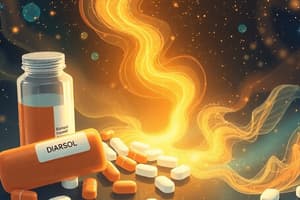Podcast
Questions and Answers
What is the primary mechanism by which sulfonylureas lower blood glucose levels?
What is the primary mechanism by which sulfonylureas lower blood glucose levels?
- They promote glucose excretion in the urine.
- They inhibit gluconeogenesis in the liver.
- They stimulate insulin secretion from pancreatic β-cells. (correct)
- They increase insulin sensitivity in peripheral tissues.
What is the typical reduction in A1C levels observed in drug-naïve patients taking sulfonylureas?
What is the typical reduction in A1C levels observed in drug-naïve patients taking sulfonylureas?
- 2.5% to 3%
- 0.5% to 1%
- 1.5% to 2% (correct)
- 3.5% to 4%
Which of the following is a significant side effect associated with the use of sulfonylureas?
Which of the following is a significant side effect associated with the use of sulfonylureas?
- Hypoglycemia (correct)
- Nausea and vomiting
- Liver damage
- Weight loss
In which scenario should the use of glyburide be avoided?
In which scenario should the use of glyburide be avoided?
What is the usual daily dosage schedule for sulfonylureas?
What is the usual daily dosage schedule for sulfonylureas?
Flashcards
Sulfonylureas
Sulfonylureas
Oral medications used to treat type 2 diabetes by stimulating insulin secretion from pancreatic beta cells.
Hypoglycemia
Hypoglycemia
The most common side effect of sulfonylureas, characterized by low blood sugar levels. It can occur due to missed meals, exercise, or weight loss.
Tachyphylaxis
Tachyphylaxis
A phenomenon where the effectiveness of sulfonylureas decreases over time, leading to less control over blood sugar.
Renal/Hepatic Impairment
Renal/Hepatic Impairment
Signup and view all the flashcards
Sulfa Allergy Cross-Reactivity
Sulfa Allergy Cross-Reactivity
Signup and view all the flashcards
Study Notes
Sulfonylureas: Treatment for Type 2 Diabetes
- Oral medications stimulating insulin secretion in pancreatic beta cells.
- They bind to sulfonylurea receptors.
- Used as monotherapy or with other oral/injectable drugs.
Second-Generation Sulfonylureas
-
Glyburide (Glibenclamide)
-
Glipizide
-
Glimepiride (Amaryl)
-
All equally effective at lowering blood glucose (BG) in equipotent doses
-
Typical A1C reduction: 1.5%–2% (16–22 mmol/mol Hb)
-
Typical fasting plasma glucose (FPG) reduction: 60–70 mg/dL
-
Typically one daily dosage
-
Taken orally with breakfast or first meal
Usage Considerations and Side Effects
- Widely used due to effectiveness, oral administration, and affordability.
- Caution advised by current guidelines due to:
- Hypoglycemia risk: Most common side effect, especially in patients with:
- Irregular meal schedules
- Intensive exercise routines
- Significant weight loss
- Requires conservative dose initiation/titration
- Weight gain: Typically 1–2 kg
- Tachyphylaxis: Reduced effectiveness over time.
- Long-acting sulfonylureas: High hypoglycemia risk in older patients and those with kidney/liver problems. Avoid or use with extreme caution.
- Renal impairment: Glyburide use is not recommended, while glipizide/glimepiride use should be cautious.
- Cardiovascular risk: Increased risk of death in patients with coronary artery disease.
- Hypoglycemia risk: Most common side effect, especially in patients with:
Cross-reactivity and Allergies
- Patients with sulfa allergies rarely experience cross-reactivity with sulfonylureas.
Studying That Suits You
Use AI to generate personalized quizzes and flashcards to suit your learning preferences.




